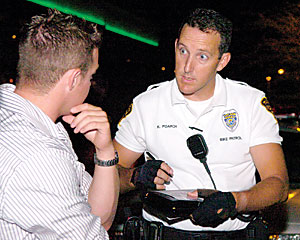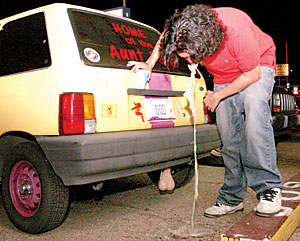 |
|
file photo
|
Campus Health officials say the effect alcohol may have on a person is proportionate to his or her height, weight, and gender. However, officials recommend no one consume more than five drinks in one sitting, regardless of size. ��
|
|
|
By Evan Pellegrino
Arizona Daily Wildcat
Wednesday, August 8, 2005
Print this
Several departments on campus deal with the effects of college students drinking alcohol, either by reprimanding or educating students. These departments are open for the safety of everyone.
The University of Arizona Police Department is a fully functioning police force that works in partnership with the Tucson Police Department and Pima County Sheriff's Department.
Its physical jurisdiction runs from North Campbell Avenue to North Euclid Avenue and East Lester Street to East Eighth Street.
UAPD's Web site reports an average of 227 liquor violations per year and an average of 50 DUIs per year from 2000-2003.
In 2004, UAPD issued 374 liquor violations and 120 DUIs.
According to UAPD Officer Chris Scheopner, the body can't process alcohol properly under the age of 21.
The age of legal consumption, is not just something "picked," Scheopner said. Scientific tests prove that 21 is an age at which the body can start "dealing with alcohol in its system."
When dealing with drinking, the biggest thing to remember, according to Scheopner, is "don't use and abuse."
 |
|
CHRIS CODUTO/Arizona Summer Wildcat
|
Bartenders and bouncers at local bars and restaurants have been trained by Tucson Police Department to spot fake IDs. If an underage person is caught using one, his or her driver's license can be suspended.��
|
|
|
Scheopner said people under the influence of alcohol often make "stupid" decisions based on feelings like being too courageous or being "overly happy," as opposed to using good judgment about the inhibitions caused by drinking.
Legally, someone under 21 years old is not allowed to have any open containers of alcohol on them or any alcohol in their system at any time. If they do, Scheopner said, they are committing a misdemeanor criminal offense.
If an underage drinker is caught on campus by a police officer, the result will usually be arrest.
There are different consequences to arrests that may be imposed on the student in these cases, Scheopner said.
 |
|
Scientific tests prove that 21 is an age at which the body can start dealing with alcohol in its system.– Chris Scheopner, UAPD Officer
|
 |
A common type of arrest is the "cite and release," or paper arrest. In most cases, when a student has no warrants and the incident is not too serious, he or she will be issued a paper arrest. The arrestee is given a court date but is free to go after the police finish the arrest process and the student is released.
When a first-offending UA student is arrested in this fashion by UAPD, the Dean of Students Office offers a diversion program to protect the student from developing a criminal record.
The student arrested will be referred to the program, and he or she can avoid being involved in county legal processes and consequences by admitting fault, Sheopner said.
"It's intended to be in-house to avoid involvement with the courts... It's to look out for the students," Scheopner said. "Look, you messed up, it happens, but you're going to get another chance."
The diversion program typically entails fines, community service and counseling.
A student who is arrested after receiving his or her first strike and has already completed the diversion program will have to deal with Pima County and receive their consequences.
The most serious type of arrest is custody. If a student is caught on campus and the officer feels he or she ought to be taken into custody, the student is transported to Pima County Jail.
According to Scheopner, those booked will spend the day or night there and will be assessed by video court within 24 hours of arrival. At that point the arrested person is in the hands of the county.
When a driver under the age of 21 is pulled over and an officer detects alcohol present in his or her system, the person is issued a "baby DUI," Scheopner said.
This can be issued without any field sobriety tests.
The "baby DUI" is the consequence for someone who is underage drinking and driving with a blood-alcohol level of less than .08, the legal limit for those over the age of 21, Sheopner said.
If the underage drunk driver is clocked at .08 blood-alcohol level or above, he or she will be issued a full-fledged DUI, which means entering a world of legal action.
Anyone under or over the age of 21 can be charged with contributing to the delinquency of a minor. If alcohol is being provided to someone underage at a party or other gathering, the provider is committing a crime. When called to a party, UAPD's usual routine is to find the person throwing the party.
If there is underage drinking at the party, the host can be charged with one or more accounts of contributing to the delinquency of a minor, Scheopner said. This charge has been known to be associated with hefty fines.
 |
|
Abusing alcohol is harmful for people of any age.– Lynn Reyes, an alcohol and drug prevention specialist at Campus Health
|
 |
Campus help
"Abusing alcohol is harmful," for people of any age, said Lynn Reyes, an alcohol and drug prevention specialist at Campus Health.
When not used in moderation, alcohol can cause a person to become unable to avoid negative consequences, Reyes said.
National statistics show that 18- to 24-year-old males are at a high risk for alcohol abuse. These are the typical years of college.
"When students drink in a risky manner, they can ignore their other responsibilities," said Reyes. The effects might seem small, like missing class or doing poorly on a class assignment, but the abuse of alcohol can lead to very serious negative results.
Reyes said she sees first-hand alcohol's relation to many negative consequences.
Campus Health physicians, nurses and specialists see many health and psychological problems result from irrational decisions made while drinking. Reyes said her office sees the effects of alcohol abuse in the form of violence, assault and sexual assault.
"Obviously (sexually transmitted diseases) come into play," said Reyes. "Impairment of judgment can lead to unsafe sex."
Although alcohol-related referrals are small compared to the student population, her office takes students who are sent by the Dean of Student's Office to help fulfill the diversion program's requirement.
Reyes also sees problems with binge-drinking on campus.
"Binge-drinking" is an "out-dated" term, she said. The limits of drinking are not generic. "The term never provided a good definition... it fits everyone into one-size."
Binge-drinking has been defined as having four, five or more drinks in one sitting. The term fails because alcohol intoxication has a lot of variables, Reyes explained.
A person's gender and size plays a large factor in his or her ability to metabolize alcohol.
A new definition of binge drinking has been created by the National Institute on Alcohol Abuse and Alcoholism, which now classifies binge-drinking as consuming enough to reach a blood alcohol point of .08 or greater, the legal drinking limit for all 50 states.
When most people drink, they're usually not aware of what their current blood alcohol level is, Reyes said.
In an effort to make .08 mean more than a mere decimal, Campus Health is currently setting up a Web site where students will get individual feedback.
Students will be able to plug in their gender and dimensions and calculate their "hours to zero blood alcohol concentration (BAC)," Reyes said.
The Campus Health site currently has a zero blood alcohol graph that illustrates how many drinks will correspond with someone's BAC, based on the person's height, weight and gender.
It is the responsibly of the individual who chooses to drink to be aware of alcohol's effect on his or her own body, Reyes said.
When someone reaches a BAC of .06 he or she starts to show impairment, Reyes said.
At a BAC of .06, differences in coordination, mood and judgment will be present, even if minor at first. If a person continues to consume past this point, his or her inhibitions will decerease rapidly. No matter a person's gender, size or experience, five drinks should be the maximum cut-off point for anyone, Reyes said.
Another up-coming program by Campus Heath will help give students an individual assessment.
Beginning in Sept., a grant will allow the center to provide students with a non-judgmental evaluation of their drinking habits. Students can talk with professionals in a comfortable and friendly environment about their drinking habits.
Not only will participating students get paid, they will learn about themselves and alcohol in a very personal way, an area where posters and statistics around campus can often fail.
It will help show students "where they're at," Reyes said.
 |
|
FILE PHOTO
|
Drinking excessive alcohol can cause harmful effects on the body including blackouts, vomiting and hangovers. Students are urged not to drink until they are of legal drinking age. ��
|
|
|
Someone with a chronic drinking problem will not be aware of the poor behavior that results, Reyes said.
She said if students think someone they know has a problem, making the person aware of it is very important.
"Talk about your concerns," Reyes said. "And let them know it effects you."
Reyes recommends that if someone may have a problem, the person should be encouraged to get a consultation from Campus Health.
One sign that alcohol may become a problem for an individual is a quickly developing tolerance to the drug, Reyes said.
"If the amount consumed needed to get that buzz increases," Reyes said, it may be a "sign of heading to a problem."
Frequent blackouts are another sign of a chronic alcohol problem, Reyes said. A problem with blackout, passing out or losing consciousness with no recollection of events that occurred, is that the person may not even be aware he or she experienced one. If a friend or roommate is in a blackout, those around likely won't be able to tell.
Ignoring responsibilities, friends and family are also signs indicating chronic alcohol abuse. Someone who becomes overly happy or violent as result of consumption should also look into getting help.
The doctor says ...
Ronald Watson, a professor for the College of Public Health, said he sees first-hand at University Medical Center the "literally hundreds" of ways alcohol can kill someone.
Watson said he has seen damage to mental function, liver disease, immune deficiencies and social abilities.
Often alcohol is associated with tobacco use and its possible consequences, like heart disease and lung cancer.
Watson explained that consumption of alcohol "decreases antioxidants as well as vitamins E and C, all of which keep you healthy."
"Most alcohol abusers don't recognize it," Watson said.
Alcohol can put someone at "high-risk for suicide," Watson explained, and drinking can lead to car accidents, rape and assault.
Watson said when people drink, especially those under the age of 21, they are "beginning an addictive process."
"Millions of people (in America) abuse alcohol," not just alcoholics, Watson said. That means "300,000,000 direct family members are affected," not including friends and co-workers.
When a woman consumes more then 2 alcoholic beverages a week, she's "increasing the risk of breast cancer," Watson said.
Drinking is not recommended, Watson said. There are "no nutritional benefits" to drinking, and there are no physiological benefits.
"Under no circumstances should a college student drink," Watson said.
